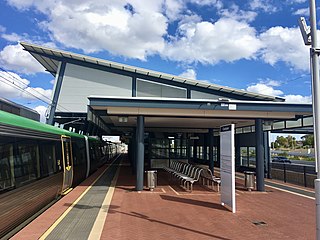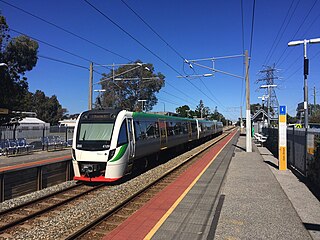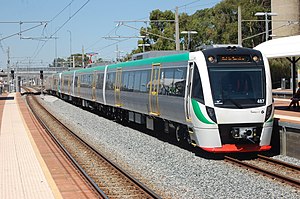
The Armadale line is a suburban railway service in Perth, Western Australia, operated by the Public Transport Authority as part of the Transperth system. The Armadale line is 30.4 kilometres (18.9 mi) long, and starts at Perth station, heading south-east of there to serve Perth's south-eastern suburbs, terminating at Armadale station.

The Joondalup line is a commuter rail service in Western Australia, linking the Perth central business district (CBD) with the metropolitan area's north-western suburbs. The service is operated on the Northern Suburbs Railway by Transperth Train Operations, a division of the Public Transport Authority, and is part of the Transperth network. It is 40.7 kilometres (25.3 mi) long and serves 13 stations. The service is currently being extended to Yanchep as part of the Yanchep Rail Extension project.

Perth railway station is the largest station on the Transperth network, serving the central business district of Perth, Western Australia. It serves as an interchange between the Airport, Armadale, Fremantle, Midland, and Thornlie lines as well as Transwa's Australind service. It is also directly connected to Perth Underground railway station, which has the Joondalup line and Mandurah line.

Clarkson railway station is a commuter rail station in Clarkson, a suburb of Perth, Western Australia. It is on the Joondalup line, which is part of the Transperth network. Located in the median of the Mitchell Freeway, the station consists of an island platform connected to the west by a pedestrian footbridge. A six stand bus interchange and two carparks are located near the entrance.

Oats Street railway station is a temporarily-closed Transperth suburban railway station in Western Australia, located in the Perth suburbs of Carlisle and East Victoria Park. The station was served by the Armadale and Thornlie lines prior to its closure in November 2023.

Victoria Park railway station is a suburban railway station on the Transperth network in Western Australia. The station is in the Perth suburbs of Lathlain and Victoria Park. Since November 2023, the station has been the terminus of the Armadale and Thornlie lines due to the Victoria Park-Canning Level Crossing Removal Project. The whole of each line is expected to reopen in mid-2025.

The Mandurah line is a commuter railway and service on the Transperth network in Western Australia that runs from Perth south to the state's second largest city Mandurah. The service is operated by Transperth Train Operations, a division of the Public Transport Authority. The line is 70.1 kilometres (43.6 mi) long and has 12 stations. At its northern end, the line begins as a continuation of the Joondalup line at Perth Underground, and ends as a continuation of the Joondalup line at Elizabeth Quay. The first 1.3 kilometres (0.81 mi) of the line is underground, passing under the Perth central business district. The line surfaces and enters the median of the Kwinana Freeway just north of the Swan River. It continues south down the freeway's median for 30 kilometres (19 mi), before veering south-west towards Rockingham. The final stretch of the line goes south from Rockingham to Mandurah.
Nowergup railway depot is a Transperth depot in the suburb of Nowergup, Western Australia. It is situated in the median of the Mitchell Freeway between the Lukin Drive and Hester Avenue interchanges.

The Australind is a currently suspended rural passenger train service in Western Australia operated by Transwa on the South Western Railway between Perth and Bunbury.

The A-series trains are a class of electric multiple unit built by Walkers Limited in Maryborough, Queensland for Transperth between 1991 and 1999. When introduced in 1991, the A-series trains became the first electric passenger trains to operate in Western Australia and until 2004, were the only type of train in use on the Perth suburban rail network.

Claisebrook railway depot is a Transperth depot adjacent to Claisebrook station, at 122 Kensington Street, East Perth. When trains leave this depot, they connect with the Midland, Fremantle, Armadale, Thornlie, and Joondalup lines.

Elizabeth Quay railway station,, is an underground railway station on the southern side of the Perth central business district in Western Australia.

Warnbro railway station is a commuter railway station in Warnbro, a suburb of Perth, Western Australia. It is on the Mandurah line, which is part of the Transperth commuter rail network, and is located immediately south-east of the interchange of Safety Bay Road and Ennis Avenue. It has two side platforms, linked by a pedestrian overpass accessed by stairs, a lift, and escalators. Services run every 10 minutes during peak, and every 15 minutes between peak. The journey to Perth Underground station is 47.5 kilometres (29.5 mi), and takes 38 minutes. The journey to Mandurah railway station is 23.3 kilometres (14.5 mi), and takes 13 minutes. The station has a bus interchange with seven bus stands and 12 regular bus routes.

Railways in Perth, the capital city of Western Australia, have existed since 1881, when the Eastern Railway was opened between Fremantle and Guildford. Today, Perth has seven Transperth commuter rail lines and 75 stations.

Transperth is the public transport system for Perth and surrounding areas in Western Australia. It is managed by the Public Transport Authority (PTA), a state government organisation, and consists of train, bus and ferry services. Bus operations are contracted out to Swan Transit, Path Transit and Transdev. Ferry operations are contracted out to Captain Cook Cruises. Train operations are done by the PTA through their Transperth Train Operations division.

The Transperth C-series trains are a planned class of electric multiple units part of Alstom's X'Trapolis family of trains for Transperth that are being delivered as part of Metronet. The trains will be operated on Perth's suburban rail network and are planned to enter service on the Joondalup and Mandurah lines on 8 April 2024.

Perth Stadium railway station is a railway station in Burswood, Western Australia, next to Perth Stadium. With six platforms, the station is the second largest on the Transperth network, after Perth railway station.

Metronet is a multi-government agency in Western Australia. It is responsible for managing extensions to Perth's rail network. It was formed to deliver commitments made by the McGowan Government during the 2017 election campaign.

The Thornlie line is a temporarily closed suburban railway line and service in Perth, Western Australia, operated by the Public Transport Authority as part of the Transperth system. The Thornlie line is a branch of the Armadale line which opened on 7 August 2005 and runs for 2.9 kilometres (1.8 mi) parallel to the Kwinana freight railway between the Armadale line at Kenwick and Thornlie station. Thornlie line services continued north of Kenwick along the Armadale line to Perth station, stopping at most stations, in contrast to Armadale line services, which skipped most stations along that section. The Thornlie line been suspended since 20 November 2023 due to construction work; it is planned to reopen in mid-2025.


















